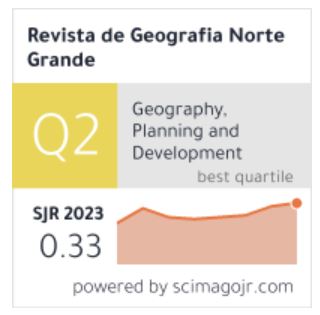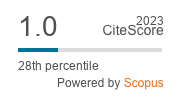SIRSD-S or the risks of a productivist problematization of degraded soils
Keywords:
Soils, degradation, problematization, productivism, ChileAbstract
Several studies have shown alarming levels of soil degradation in Chile, a fundamental pillar of biodiversity and food production. This recognition has led in recent decades to the implementation of soil governance, through which this situation can begin to be reversed. Adopting an analytical framework of social studies of soils, this article analyzes the main public instrument generated for this purpose, the "Incentive System for the Recovery of Degraded Soils" (SIRSD-S). By following its history and implementation in the Atacama Region, the article presents SIRSD-S as framed in a productivist problematization. From this approach, agricultural soils tend to be understood mainly as an inert infrastructure for food production, especially under a monoculture and export-oriented agroindustrial model. As a result, SIRSD-S tends to give primacy to action plans focused on the introduction of singular technical amendments focused on maintaining the current productivity of soils. By neglecting any recognition of soils as part of complex socio-ecologies, these measures fail to actually mitigate - and even help worsen - the conditions that led to the degradation of these soils in the first place. In the conclusions we will explore some changes to this policy that could help to actually achieve its initial goal of reducing the levels of agricultural soil degradation in Chile.
Downloads
References
ANDERSON, Molly D y RIVERA-FERRE, Marta, 2021. Food system narratives to end hunger: extractive versus regenerative. Current Opinion in Environmental Sustainability. en línea. 1 abril 2021. Vol. 49, pp. 18–25. [Accedido 25 junio 2022]. DOI 10.1016/j.cosust.2020.12.002.
ANDERSSON, Elina, BROGAARD, Sara y OLSSON, Lennart, 2011. The Political Ecology of Land Degradation. Annual Review of Environment and Resources. en línea. 2011. Vol. 36, no. 1, pp. 295–319. [Accedido 18 agosto 2016]. DOI 10.1146/annurev-environ-033110-092827.
BAVEYE, Philippe C., RANGEL, David, JACOBSON, Astrid R., LABA, Magdeline, DARNAULT, Christophe, OTTEN, Wilfred, RADULOVICH, Ricardo y CAMARGO, Flavio A. O., 2011. From Dust Bowl to Dust Bowl: Soils are Still Very Much a Frontier of Science. Soil Science Society of America Journal. en línea. 2011. Vol. 75, no. 6, pp. 2037–2048. [Accedido 27 agosto 2022]. DOI 10.2136/sssaj2011.0145.
BONOMELLI, Claudia, BONILLA, Carlos y VALENZUELA, Adriana, 2003. Efecto de la fertilización fosforada sobre el contenido de cadmio en cuatro suelos de Chile. Pesquisa Agropecuária Brasileira. en línea. octubre 2003. Vol. 38, pp. 1179–1186. [Accedido 13 septiembre 2022]. DOI 10.1590/S0100-204X2003001000007.
BULL, Alan T., ASENJO, Juan A., GOODFELLOW, Michael y GÓMEZ-SILVA, Benito, 2016. The Atacama Desert: Technical Resources and the Growing Importance of Novel Microbial Diversity. Annual Review of Microbiology. en línea. 2016. Vol. 70, no. 1, pp. 215–234. [Accedido 21 marzo 2020]. DOI 10.1146/annurev-micro-102215-095236.
CALLON, M., 1986. The Sociology of the Actor-Network: the Case of the Electric Vehicle. En: Mapping the Dynamics of Science and Technology: Sociology of Science in the Real World. London: Macmillan.
CASANOVA, M., SALAZAR, O., SEGUEL, O. y LUZIO, W., 2013. The Soils of Chile. New York: Springer. ISBN 978-94-007-5949-7.
CASTRO, C. P., SOTO, M. V., FERNANDEZ, R., MÄRKER, M. y RODOLFI, G., 2009. Impacto en la geodinámica actual del valle de Nantoco, cuenca del río Copiapó, asociado a la reconversión productiva. Revista de geografía Norte Grande. en línea. mayo 2009. No. 42, pp. 81–99. [Accedido 18 agosto 2016]. Recuperado a partir de: http://www.scielo.cl/scielo.php?script=sci_abstract&pid=S0718-34022009000100006&lng=es&nrm=iso&tlng=e
CIREN, 2010. Determinación de la erosión actual y potencial de los suelos de Chile - Atacama. Santiago: Centro de Información de Recursos Naturales.
CONSTANCE, D. y MOSELEY, A., 2018. Agrifood discourses and feeding the world : Unpacking sustainable intensification. En: Contested Sustainability Discourses in the Agrifood System. en línea. London: Routledge. pp. 59–74. [Accedido 25 junio 2022]. ISBN 978-1-315-16129-7. container-title: Contested Sustainability Discourses in the Agrifood System
DAVIS, Diana K., 2018. Desertification. En: Companion to Environmental Studies. London: Routledge. ISBN 978-1-315-64005-1.
DE SCHUTTER, Olivier, 2014. The Specter of Productivism and Food Democracy. Wisconsin Law Review. en línea. 2014. Vol. 2014, pp. 199. Recuperado a partir de: https://heinonline.org/HOL/Page?handle=hein.journals/wlr2014&id=208&div=&collection=
DOMÍNGUEZ, ERRÁZURIZ, F. y MUCHNIK, E., 1996. Efectos de la asociación de Chile al Mercosur en el sector agrícola y agroindustrial. Estudios Públicos. en línea. 1 junio 1996. No. 63. [Accedido 19 agosto 2022]. Recuperado a partir de: https://www.estudiospublicos.cl/index.php/cep/article/view/1132
EMG, 2002. Estudio del impacto del sistema de incentivos para recuperación de suelos degradados. Santiago: EMG Consultores.
ENGEL-DI MAURO, S., 2014. Ecology, Soils, and the Left: An Eco-Social Approach. New York: Pallgrave.
FAO, 2015. Status of the World’s Soil Resources. Rome.
FOUILLEUX, Eve, BRICAS, Nicolas y ALPHA, Arlène, 2017. ‘Feeding 9 billion people’: global food security debates and the productionist trap. Journal of European Public Policy. en línea. 29 noviembre 2017. Vol. 24, no. 11, pp. 1658–1677. [Accedido 15 julio 2022]. DOI 10.1080/13501763.2017.1334084.
GARNETT, T., APPLEBY, M. C., BALMFORD, A., BATEMAN, I. J., BENTON, T. G., BLOOMER, P., BURLINGAME, B., DAWKINS, M., DOLAN, L., FRASER, D., HERRERO, M., HOFFMANN, I., SMITH, P., THORNTON, P. K., TOULMIN, C., VERMEULEN, S. J. y GODFRAY, H. C. J., 2013. Sustainable Intensification in Agriculture: Premises and Policies. Science. en línea. 5 julio 2013. Vol. 341, no. 6141, pp. 33–34. [Accedido 25 junio 2022]. DOI 10.1126/science.1234485.
GAYMER, M., ARENAS, D., SALGADO, E. y VALDEBENITO, G., 2009. Informe final de evaluación - Programa Recuperación de Suelos Degradados. Santiago de Chile: Ministerio de Agricultura - Gobierno de Chile.
GODFRAY, H. Charles J., 2015. The debate over sustainable intensification. Food Security. en línea. 1 abril 2015. Vol. 7, no. 2, pp. 199–208. [Accedido 11 julio 2022]. DOI 10.1007/s12571-015-0424-2.
GOODWIN, Charles, 1994. Professional Vision. American Anthropologist. en línea. 1 septiembre 1994. Vol. 96, no. 3, pp. 606–633. [Accedido 25 febrero 2016]. Recuperado a partir de: http://onlinelibrary.wiley.com/doi/10.1525/aa.1994.96.3.02a00100/abstract
GREZ, H., 2010. Análisis de un instrumento de política agrícola : El programa para la recuperación de suelos degradados (SIRSD). Concepción, Chile: Universidad de Concepción. Accepted: 2015-01-21T14:53:18Zpublisher: Santiago: FLACSO Chile: Universidad de Concepción
HAY, C., 1999. Crisis and the structural transformation of the state: interrogating the process of change. British Journal of Politics and International Relations. 1999. Vol. 1, no. 3, pp. 317–344.
HUESEMANN, M. y HUESEMANN, J., 2011. Techno-Fix: Why Technology Won’t Save Us Or the Environment. Toronto: New Society Publishers. ISBN 978-0-86571-704-6. Google-Books-ID: KZ3zAgAAQBAJ
JANKER, Judith, MANN, Stefan y RIST, Stephan, 2018. What is Sustainable Agriculture? Critical Analysis of the International Political Discourse. Sustainability. en línea. diciembre 2018. Vol. 10, no. 12, pp. 4707. [Accedido 12 julio 2022]. DOI 10.3390/su10124707.
JORQUERA-JARAMILLO, C., 2008. Agricultura y Flora Nativa en la Región de Atacama:¿Es Posible Producir y Conservar? En: SQUEO, F.A. (ed.), Libro Rojo de la Flora Nativa y de los Sitios Prioritarios para su Conservación: Región de Atacama. La Serena: Ediciones Universidad de La Serena.
JUERGES, Nataly y HANSJÜRGENS, Bernd, 2018. Soil governance in the transition towards a sustainable bioeconomy – A review. Journal of Cleaner Production. en línea. 1 enero 2018. Vol. 170, pp. 1628–1639. [Accedido 2 febrero 2022]. DOI 10.1016/j.jclepro.2016.10.143.
KRZYWOSZYNSKA, A., 2020. Nonhuman labor and the making of resources : making soils a resource through microbial labor. Environmental Humanities. 2020.
LUZIO, W. (ed.), 2010. Suelos de Chile. Santiago de Chile: Editorial Universitaria.
MAHON, Niamh, CRUTE, Ian, SIMMONS, Eunice y ISLAM, Md. Mofakkarul, 2017. Sustainable intensification – “oxymoron” or “third-way”? A systematic review. Ecological Indicators. en línea. 1 marzo 2017. Vol. 74, pp. 73–97. [Accedido 25 junio 2022]. DOI 10.1016/j.ecolind.2016.11.001.
MARTÍ, L., BURBA, J. N. y CAVAGNARO, M., 2002. Metales pesados en fertilizantes fosfatados, nitrogenados y mixtos. Rev Fac Cienc Agrar. 2002. Vol. 34, no. 2, pp. 43–48.
MCGOEY, Linsey, 2012. Strategic unknowns: towards a sociology of ignorance. Economy and Society. en línea. 1 febrero 2012. Vol. 41, no. 1, pp. 1–16. [Accedido 1 julio 2020]. DOI 10.1080/03085147.2011.637330.
MÜLLER, Birgit, 2021. Glyphosate—A love story. Ordinary thoughtlessness and response-ability in industrial farming. Journal of Agrarian Change. en línea. 2021. Vol. 21, no. 1, pp. 160–179. [Accedido 29 julio 2022]. DOI 10.1111/joac.12374.
NIEMEYER, H., CERVELLINO, M. y CASTILLO, G., 1998. Culturas Prehistóricas de Copiapó. Copiapó, Chile: Museo Regional de Atacama.
OCDE-CEPAL, 2016. Evaluaciones de desempeño ambiental - Chile 2016. Santiago.
ODEPA y CIREN, 2018. Catastro Frutícola Región de Atacama. Principales Resultados. Santiago de Chile: Oficina de Estudios y Políticas Agrarias - Ministerio de Agricultura.
PINOCHET, D., CÁRDENAS, C. y CARRASCO, J., 2017. ¿Cambia la mineralización del nitrógeno desde abonos orgánicos compost, bokashi y biol provenientes del mismo guano de gallina? Agro sur. en línea. 31 agosto 2017. Vol. 45, no. 2, pp. 47–56. [Accedido 7 septiembre 2022]. DOI 10.4206/agrosur.2017.v45n2-05.
POSMANIK, Roy, SINAY, Boaz Bar, GOLAN, Ramy, NEJIDAT, Ali y GROSS, Amit, 2011. Reuse of Stabilized Fowl Manure as Soil Amendment and Its Implication on Organic Agriculture Nutrition Management. Water, Air, & Soil Pollution. en línea. 1 marzo 2011. Vol. 216, no. 1, pp. 537–545. [Accedido 25 agosto 2022]. DOI 10.1007/s11270-010-0551-5.
PUIG DE LA BELLACASA, M., 2015. Making time for soil: Technoscientific futurity and the pace of care. Social Studies of Science. 4 septiembre 2015. pp. 0306312715599851.
QIN, Xuechao, GUO, Shufang, ZHAI, Limei, PAN, Junting, KHOSHNEVISAN, Benyamin, WU, Shuxia, WANG, Hongyuan, YANG, Bo, JI, Jinghong y LIU, Hongbin, 2020. How long-term excessive manure application affects soil phosphorous species and risk of phosphorous loss in fluvo-aquic soil. Environmental Pollution. en línea. 1 noviembre 2020. Vol. 266, pp. 115304. [Accedido 13 julio 2022]. DOI 10.1016/j.envpol.2020.115304.
REYNOLDS, J. y STAFFORD, M., 2002. Do Humans Cause Deserts? En: Global Desertification: Do Humans Cause Deserts?. Berlin: Dahlem University Press.
RIETVELD, Anne M., GROOT, Jeroen C. J. y VAN DER BURG, Margreet, 2021. Predictable patterns of unsustainable intensification. International Journal of Agricultural Sustainability. en línea. 24 junio 2021. Vol. 0, no. 0, pp. 1–17. [Accedido 25 junio 2022]. DOI 10.1080/14735903.2021.1940731.
RINAUDO, Jean-Daniel y DONOSO, Guillermo, 2019. State, market or community failure? Untangling the determinants of groundwater depletion in Copiapó (Chile). International Journal of Water Resources Development. en línea. 4 marzo 2019. Vol. 35, no. 2, pp. 283–304. [Accedido 12 agosto 2022]. DOI 10.1080/07900627.2017.1417116.
SALAZAR, Juan Francisco, GRANJOU, Céline, KEARNES, Matthew, KRZYWOSZYNSKA, Anna y TIRONI, Manuel, 2020. Thinking with Soils: Material Politics and Social Theory. London: Bloomsbury Academic. ISBN 978-1-350-10957-5. Google-Books-ID: HcHYxwEACAAJ
SIERRA, C., CESPEDES, R. y OSORIO, A., 2001. Caracterización de la salinidad de los suelos y aguas del valle del río Copiapó. Boletín INIA N°70. en línea. 2001. [Accedido 12 agosto 2022]. Recuperado a partir de: https://bibliotecadigital.ciren.cl/handle/20.500.13082/32126Accepted: 2020-12-21T11:51:41Z
SIERRA, C. y OLIVARES, R., 2010. Cero labranza con manejo de residuos en frutales y vides: aporta mas materia orgánica y requiere menos fertilizantes. Tierra Adentro. 2010. Vol. 90, pp. 14–16.
SUMBERG, James, THOMPSON, John y WOODHOUSE, Philip, 2013. The Changing Politics of Agronomy Research. Outlook on Agriculture. en línea. 1 junio 2013. Vol. 42, no. 2, pp. 81–83. [Accedido 12 julio 2022]. DOI 10.5367/oa.2013.0122.
THOMPSON, P., 1994. The Spirit of the Soil: Agriculture and Environmental Ethics. 2. New York: Routledge. ISBN 978-1-315-55997-1.
TIRONI, M., KEARNES, M., SALAZAR, J., GRANJOU, C. y KRZYWOSZYNSKA, A., 2020. Soil Theories: Relational, Decolonial, Inhuman. En: Thinking with soils- social theory and material politics. en línea. London: Bloomsbury Academic. pp. 40. [Accedido 24 junio 2020]. ISBN 978-1-350-10957-5. Recuperado a partir de: https://hal.inrae.fr/hal-02609906
UNIVERSIDAD DE CHILE, 2012. Informe país estado del medio ambiente en Chile 2012. Santiago de Chile: LOM / Universidad de Chile.
UTRILLA, S. y VELIZ, J., 2010. Desarrollo de la viticultura y servicios para la producción en el valle de Copiapó (Chile). Revista de geografía Norte Grande. 2010. Vol. 46, pp. 67–84.
VEGA-LEINERT, Anne Cristina de la y CLAUSING, Peter, 2016. Extractive Conservation: Peasant Agroecological Systems as New Frontiers of Exploitation? Environment and Society. en línea. 1 septiembre 2016. Vol. 7, no. 1, pp. 50–70. [Accedido 11 julio 2022]. DOI 10.3167/ares.2016.070104.
Downloads
Published
How to Cite
Issue
Section
License
Copyright (c) 2024 Revista de Geografía Norte Grande

This work is licensed under a Creative Commons Attribution 4.0 International License.






